The Cellular Basis of Chapter 8 Reproduction and

The Cellular Basis of Chapter 8 Reproduction and Inheritance Power. Point Lectures for Biology: Concepts & Connections, Sixth Edition Campbell, Reece, Taylor, Simon, and Dickey Copyright © 2009 Pearson Education, Inc. Lecture by Richard L. Myers Translated by Nabih A. Baeshen

CONNECTIONS BETWEEN CELL DIVISION AND REPRODUCTION Copyright © 2009 Pearson Education, Inc.

8. 1 Like begets like, more or less Living organisms reproduce by two methods – Asexual reproduction – Offspring are identical to the original cell or organism – Involves inheritance of all genes from one parent – Sexual reproduction – Offspring are similar to parents, but show variations in traits – Involves inheritance of unique sets of genes from two parents Copyright © 2009 Pearson Education, Inc.

8. 3 Prokaryotes reproduce by binary fission Binary fission means “dividing in half” – Occurs in prokaryotic cells – Two identical cells arise from one cell – Steps in the process: – A single circular chromosome duplicates, and the copies begin to separate from each other – The cell elongates, and the chromosomal copies separate further – The plasma membrane grows inward at the midpoint to divide the cells Copyright © 2009 Pearson Education, Inc.

Plasma membrane Prokaryotic chromosome Cell wall 1 Duplication of chromosome and separation of copies Binary fission of a prokaryotic cell 2 Continued elongation of the ﺍ cell and movement of copies 3 Division into two daughter cells

THE EUKARYOTIC CELL CYCLE AND MITOSIS Copyright © 2009 Pearson Education, Inc.

8. 4 The large, complex chromosomes of eukaryotes duplicate with each cell division Eukaryotic chromosomes are composed of chromatin – Chromatin = DNA + proteins – To prepare for division, the chromatin becomes highly compact, and the chromosomes are visible with a microscope – Early in the division process, chromosomes duplicate – Each chromosome appears as two sister chromatids, containing identical DNA molecules – Sister chromatids are joined at the centromere, a narrow region Copyright © 2009 Pearson Education, Inc.

Sister chromatids Chromosome duplication Sister chromatids Centromere Electron micrograph of a duplicated chromosome Chromosome distribution to daughter cells Chromosome duplication and distribution

8. 5 The cell cycle multiplies cells The cell cycle is an ordered sequence of events for cell division It consists of two stages INTERPHASE Interphase: duplication of cell contents G 1: growth, increase in cytoplasm S: duplication of chromosomes G 2: growth, preparation for division S G 1 - es (DNA synthesis) ito to Cy MIT PHA OTIC SE (M) si s n ki M Mitotic phase: divisi. Mitosis: division of the nucleus Cytokinesis: division of cytoplasm is G 2 The eukaryotic cell cycle Copyright © 2009 Pearson Education, Inc.

8. 6 Cell division is a continuum of dynamic changes Mitosis progresses through a series of stages – – – Prophase Prometaphase Metaphase Anaphase Telophase Cytokinesis often overlaps telophase Copyright © 2009 Pearson Education, Inc.

8. 6 Cell division is a continuum of dynamic changes A mitotic spindle is required to divide the chromosomes – The mitotic spindle is composed of microtubules – It is produced by centrosomes, structures in the cytoplasm that: – Organize microtubule arrangement – Contain a pair of centrioles in animal cells – – The role of centrioles in cell division is unclear Copyright © 2009 Pearson Education, Inc.

PROPHASE INTERPHASE PROMETAPHASE Fragments of Centrosomes Chromatin. Early mitotic spindle Centrosome Nuclear envelope (with centriole pairs) Nucleolus ﺍﻝ Nuclear Envelope Centromere Plasma Membrane Chromosome, consisting of two sister chromatids Kinetochore ﺓ Spindle Microtubules

8. 6 Cell division is a continuum of dynamic changes Interphase – In the cytoplasm – Cytoplasmic contents double – Two centrosomes form – In the nucleus – Chromosomes duplicate during the S phase – Nucleoli, sites of ribosome assembly, are visible Copyright © 2009 Pearson Education, Inc.

METAPHASE ANAPHASE Cleavage furrow Metaphase plate Spindle TELOPHASE AND CYTOKINESIS ﺍ Daughter chromosomes Nuclear envelope Forming Nucleolus Forming

8. 7 Cytokinesis differs for plant and animal cells Cytokinesis cells Cleavage in animal – A cleavage furrow forms from a contracting ring of microfilaments, interacting with myosin – The cleavage furrow deepens to separate the contents into two cells – Cytokinesis in plant cells – A cell plate forms in the middle from vesicles containing cell wall material – The cell plate grows outward to reach the edges, dividing the contents into two cells – Each cell has a plasma membrane and cell wall Copyright © 2009 Pearson Education, Inc.

Cleavage furrow Contracting ring of Microfilaments ﺓ Daughter cells

Growth (in an onion root) (

Mitosis prophase ﻯ Metaphase Telophase Early Anaphase Midi Anaphase Late Anaphase Telophase

MEIOSIS AND CROSSING OVER Copyright © 2009 Pearson Education, Inc.

8. 12 Chromosomes are matched in homologous pairs Somatic cells have pairs of homologous chromosomes, receiving one member of each pair from each parent Length – Centromere position – Gene locations – A locus (plural, loci) is the position of a gene – Different versions of a gene may be found at the same locus on maternal and paternal chromosomes Copyright © 2009 Pearson Education, Inc.

8. 12 Chromosomes are matched in homologous pairs Homologous pair ofchromosomes The human sex chromosomes X and Y differ in size and genetic composition Pairs of autosomes have the same size and genetic composition Centromere Sister chromatids One duplicated chromosome A homologous pair of chromosomes

8. 13 Gametes have a single set of chromosomes Meiosis is a process that converts diploid nuclei to haploid nuclei – Diploid cells have two homologous sets of chromosomes “ – – Haploid cells have one set of chromosomes – Meiosis occurs in the sex organs, producing gametes—sperm and eggs Fertilization is the union of sperm and egg – The zygote has a diploid chromosome number, one set from each parent

8. 14 Meiosis reduces the chromosome number from diploid to haploid Like mitosis, meiosis is preceded by interphase – Chromosomes duplicate during the S phase Unlike mitosis, meiosis has two divisions – During meiosis I, homologous chromosomes separate – The chromosome number is reduced by half – During meiosis II, sister chromatids separate – The chromosome number remains the same

8. 14 Meiosis reduces the chromosome number from diploid to haploid Events in the nucleus during meiosis I –Prophase I – Chromosomes coil and become compact – Homologous chromosomes come together as pairs by synapsis – Each pair, with four chromatids, is called a tetrad – Nonsister chromatids exchange genetic material by crossing over

MEIOSIS I: Homologous chromosomes separate ﺍﻧﻔﺼﺎﻝ ﺍﻷﺰﻭﺍﺝ ﺍﻟﻜﺮﻭﻣﻮﺯﻣﻮﻣﻴﺔ ﺍﻟﻤﺘﻤﺎﺛﻠﺔ : ﺍﻻﻧﻘﺴﺎﻡ ﺍﻻﺧﺘﺰﺍﻟﻲ ﺍﻷﻮﻝ INTERPHASE ﺍﻟﻄﻮﺭ ﺍﻟﺒﻴﻨﻲ Centrosomes (with Centriole pairs) PROPHASE I ﺍﻟﻄﻮﺭ ﺍﻟﺘﻤﻬﻴﺪﻱ ﺍﻷﻮﻝ Sites of crossing over ( ANAPHASE I ﺍﻟﻄﻮﺭ ﺍﻻﻧﻔﺼﺎﻟﻲ ﺍﻷﻮﻝ METAPHASE I ﺍﻟﻄﻮﺭ ﺍﻻﺳﺘﻮﺍﺋﻲ ﺍﻷﻮﻝ Microtubules attached to Kinetochore Metaphase Plate Sister chromatids remain attached Spindle Nuclear Envelope Sister Chromatin Chromatids Tetrad Centromere (with kinetochore) The stages of miosis I Homologous chromosomes separate

MEIOSIS II: Sister chromatids separate ﺍﻧﻔﺼﺎﻝ ﺍﻟﻜﺮﻭﻣﺎﺗﻴﺪﺍﺕ ﺍﻟﺸﻘﻴﻘﺔ : ﺍﻻﻧﻘﺴﺎﻡ ﺍﻻﺧﺘﺰﺍﻟﻲ ﺍﻟﺜﺎﻧﻲ TELOPHASE I AND CYTOKINESIS PROPHASE II METAPHASE II ANAPHASE II TELOPHASE II AND CYTOKINESIS Cleavage furrow Sister chromatids Separate The stages of miosis II Haploid daughter cells forming

MEIOSIS A B C D E F G H I A. B. C. D. E. F. G. H. I. PROPHASE I METAPHASE I ANAPHASE I TELOPHASE I PROPHASE II METAPHASE II ANAPHASE II TELOPHASE II TETRAD

Chapter 9 Patterns Power. Point Lectures for Biology: Concepts & Connections, Sixth Edition Campbell, Reece, Taylor, Simon, and Dickey Copyright © 2009 Pearson Education, Inc. Lecture by Richard L. Myers Translated by Nabih A. Baeshen

MENDEL’S LAWS Copyright © 2009 Pearson Education, Inc.

9. 1 The science of genetics has ancient roots Pangenesis was an early explanation for inheritance It was proposed by Hippocrates Particles called pangenes came from all parts of the organism to be incorporated into eggs or sperm Characteristics acquired during the parents’ lifetime could be transferred to the offspring Aristotle rejected pangenesis and argued that instead of particles, the potential to produce the traits was inherited Blending was another idea, based on plant breeding Hereditary material from parents mixes together to form an intermediate trait, like mixing paint Copyright © 2009 Pearson Education, Inc.

9. 2 Experimental genetics began in an abbey garden Gregor Mendel discovered principles of genetics in experiments with the garden pea Mendel showed that parents pass heritable factors to offspring (heritable factors are now called genes) Advantages of using pea plants Controlled matings Self-fertilization or cross-fertilization Observable characteristics with two distinct forms True-breeding strain Copyright © 2009 Pearson Education, Inc.

Character Flower color Dominant Trait Recessive Trait Purple White Axial Terminal Seed color Yellow Green Seed shape Round Wrinkled Inflated Constricted Green Yellow Tall Dwarf Flower position Pod shape Pod color Stem length The seven pea characteristics studied by Mendel

9. 3 Mendel’s law of segregation describes the inheritance of a single character Example of a monohybrid cross Parental generation: purple flowers white flowers F 1 generation: all plants with purple flowers F 2 generation: of plants with purple flowers of plants with white flowers Mendel needed to explain Why one trait seemed to disappear in the F 1 generation Why that trait reappeared in one quarter of the F 2 offspring Copyright © 2009 Pearson Education, Inc.

P generation (true-breeding ) parents) Purple flowers White flowers All plants have purple flowers F 1 generation Fertilization among F 1 plants (F 1 F 1) F 2 generation ﻳﺔ ¾ of plants have purple flowers ¼ of plants have white flowers Crosses tracking one character (flower color)

P P plants p Genetic makeup (alleles) pp PP p P Gametes P p All P P F 1 plants (hybrids) p P 1 – 2 Gametes All Pp 1 – 2 P Sperm P Phenotypic ratio 3 purple : 1 white F 2 plants Genotypic ratio 1 PP : 2 Pp : 1 pp P P P Eggs ﺍﻟﺒﻴﺾ p p Explanation of the crosses in previous figure p PP Pp Pp pp p

Gene loci Dominant allele Genotype: P a B P a b PP aa Bb Homozygous for the dominant allele Homozygous for the recessive allele Recessive allele Heterozygous Matching gene loci on homologous chromosomes

9. 8 CONNECTION: Genetic traits in humans can be tracked through family pedigrees A pedigree Shows the inheritance of a trait in a family through multiple generations Demonstrates dominant or recessive inheritance Can also be used to deduce genotypes of family members Copyright © 2009 Pearson Education, Inc.

Dominant Traits Freckles Recessive Traits No freckles Examples of singlegene inherited traits in humans Widow’s peak Straight hairline Free earlobe Attached earlobe

Examples of single-gene inherited traits in humans Genotype Dominant Traits FF or Ff Phenotype Free earlobe Recessive Traits ff Attached earlobe

First generation (grandparents) Ff Ff ff ( Second generation (parents, aunts, and uncles) FF or Ff ff ff Ff Third generation (two sisters) ( Female ﺃ ff Male FF or Ff Affected“ Unaffected Pedigree showing inheritance of attached versus free earlobe in a hypothetical family

Parents Normal Dd � Sperm D Offspring Eggs D d Normal Dd DD Normal Dd Normal (carrier) “ ﻁ d Dd Normal (carrier) “ dd Deaf Offspring produced by parents who are both carriers for a recessive diorder

VARIATIONS ON MENDEL’S LAWS Copyright © 2009 Pearson Education, Inc.

9. 11 Incomplete dominance results in intermediate phenotypes Incomplete dominance Neither allele is dominant over the other Expression of both alleles is observed as an intermediate phenotype in the heterozygous individual Copyright © 2009 Pearson Education, Inc.

P generation Red RR White rr Gametes r R F 1 generation Pink Rr 1 – 2 Gametes 1 – 2 R r Sperm 1 – 2 F 2 generation 1 – 2 R 1 – 2 r Eggs R r RR RR r. R Rr 1 – 2 rr Incomplete dominance in snapdragon color

9. 20 Chromosomes determine sex in many species X-Y system in mammals, fruit flies = XO ; = XX = ZZ =ZW XX = female; XO = male Z-W in system in birds, butterflies, and some fishes = XY ; = ﺃ XX X-O system in grasshoppers and roaches XX = female; XY = male ZW = female, ZZ = male Chromosome number in ants and bees Diploid = female; haploid = male

(male) (female) )( ()ﺃ 44 44 Parents’ + diploid cells + XY \ XX 22 + X X-Y system 22 + X 22 + Y Sperm ﺣﻴﻮﺍﻧﺎﺕ ﻣﻨﻮﻳﺔ 44 + XX Offspring (diploid) \( Egg ﺏ 44 + XY

22 + XX 76 + ZW 32 X-O system X-O Z-W system Z-W 22 + X 76 + ZZ 16 Chromosome number system

Chapter 10 Molecular Biology of the Gene Power. Point Lectures for Biology: Concepts & Connections, Sixth Edition Campbell, Reece, Taylor, Simon, and Dickey Copyright © 2009 Pearson Education, Inc. Lecture by Richard L. Myers Translated by Nabih A. Baeshen

MOLECULAR STRUCTURE OF THE GENETIC MATERIAL Copyright © 2009 Pearson Education, Inc.

10. 2 DNA and RNA are polymers of nucleotides The monomer unit of DNA and RNA is the nucleotide, containing – 5 -carbon sugar – Phosphate group – Nitrogenous base A sugar-phosphate backbone is formed by covalent bonding between the phosphate of one nucleotide and the sugar of the next nucleotide Nitrogenous bases extend from the sugar-phosphate backbone Copyright © 2009 Pearson Education, Inc.

Sugar-phosphate backbone Phosphate group Nitrogenous base Sugar ﺭ DNA nucleotide Nitrogenous base (A, G, C, or T) Phosphate group Thymine (T) ﺍﻝ Sugar (deoxyribose) ( DNA nucleotide DNA polynucleotide The structure of DNA polynucleotide

10. 3 DNA is a double-stranded helix DNA is composed of two polynucleotide chains joined together by hydrogen bonding between bases, twisted into a helical shape – The sugar-phosphate backbone is on the outside – The nitrogenous bases are perpendicular to the backbone in the interior – Specific pairs of bases give the helix a uniform shape – A pairs with T, forming two hydrogen bonds – G pairs with C, forming three hydrogen bonds Copyright © 2009 Pearson Education, Inc.

Hydrogen bond Base pair Ribbon model Partial chemical structure Three presentations of DNA Computer model

11. 3 DNA packing in eukaryotic chromosomes helps regulate gene expression Eukaryotic chromosomes undergo multiple levels of folding and coiling, called DNA packing – Nucleosomes are formed when DNA is wrapped around histone proteins – “Beads on a string” appearance – Each bead includes DNA plus 8 histone molecules – String is the linker DNA that connects nucleosomes – Tight helical fiber is a coiling of the nucleosome string – Supercoil is a coiling of the tight helical fiber – Metaphase chromosome represents the highest level of packing DNA packing can prevent transcription Copyright © 2009 Pearson Education, Inc.

11. 3 DNA packing in eukaryotic chromosomes helps regulate gene expression Metaphase Chromosome DNA double helix (2 -nm diameter) Tight helical fiber (30 -nm diameter) Linker “Beads on a string” Nucleosome (10 -nm diameter) Histones Supercoil (300 -nm diameter) 700 nm DNA packing in a eukaryotic chromosome

10. 4 DNA replication depends on specific base pairing DNA replication follows a semiconservative model – The two DNA strands separate – Each strand is used as a pattern to produce a complementary strand, using specific base pairing – Each new DNA helix has one old strand with one new strand Copyright © 2009 Pearson Education, Inc.

Untwisting and replication of DNA semiconservativel Nucleotides Parental molecule of DNA Both parental strands serve as templates Two identical daughter molecules of DNA A template mode for DNA replication

THE FLOW OF GENETIC INFORMATION FROM DNA TO RNA TO PROTEIN Copyright © 2009 Pearson Education, Inc.
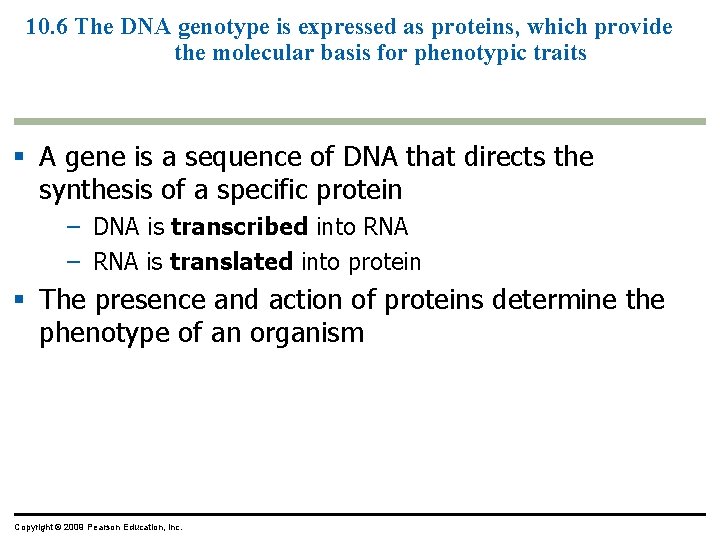
10. 6 The DNA genotype is expressed as proteins, which provide the molecular basis for phenotypic traits A gene is a sequence of DNA that directs the synthesis of a specific protein – DNA is transcribed into RNA – RNA is translated into protein The presence and action of proteins determine the phenotype of an organism Copyright © 2009 Pearson Education, Inc.

Genotype DNA Transcription Nucleus RNA Cytoplasm Translation Phenotype Protein Flow of genetic information in a eukaryotic cell

10. 7 Genetic information written in codons is translated into amino acid sequences The sequence of nucleotides in DNA provides a code for constructing a protein –Protein construction requires a conversion of a nucleotide sequence to an amino acid sequence –Transcription rewrites the DNA code into RNA, using the same nucleotide “language” –Each “word” is a codon, consisting of three nucleotides –Translation involves switching from the nucleotide “language” to amino acid “language” –Each amino acid is specified by a codon – 64 codons are possible – Some amino acids have more than one possible codon Copyright © 2009 Pearson Education, Inc.

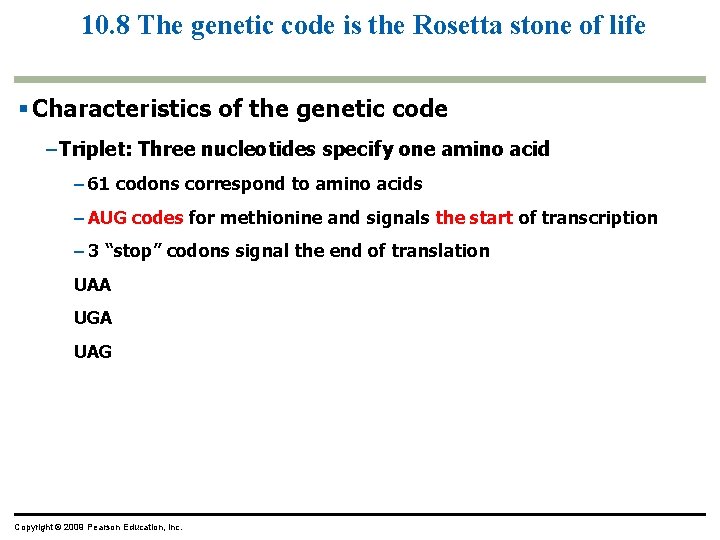
10. 8 The genetic code is the Rosetta stone of life Characteristics of the genetic code – Triplet: Three nucleotides specify one amino acid – 61 codons correspond to amino acids – AUG codes for methionine and signals the start of transcription – 3 “stop” codons signal the end of translation UAA UGA UAG Copyright © 2009 Pearson Education, Inc.
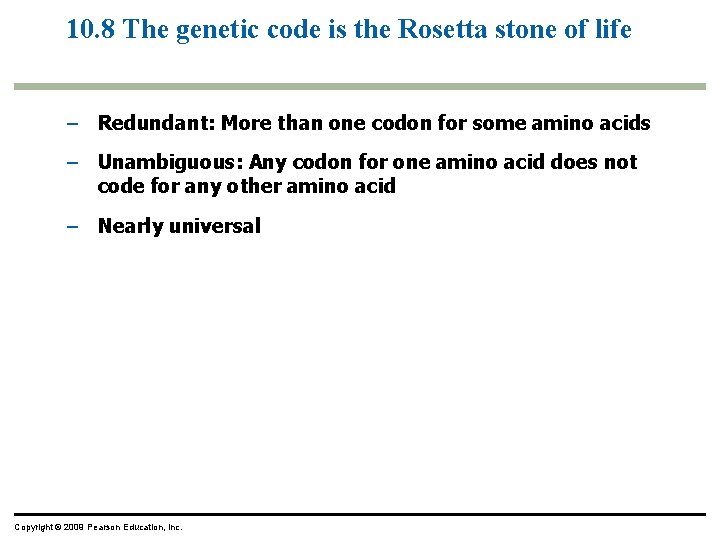
10. 8 The genetic code is the Rosetta stone of life – Redundant: More than one codon for some amino acids – Unambiguous: Any codon for one amino acid does not code for any other amino acid – Nearly universal Copyright © 2009 Pearson Education, Inc.
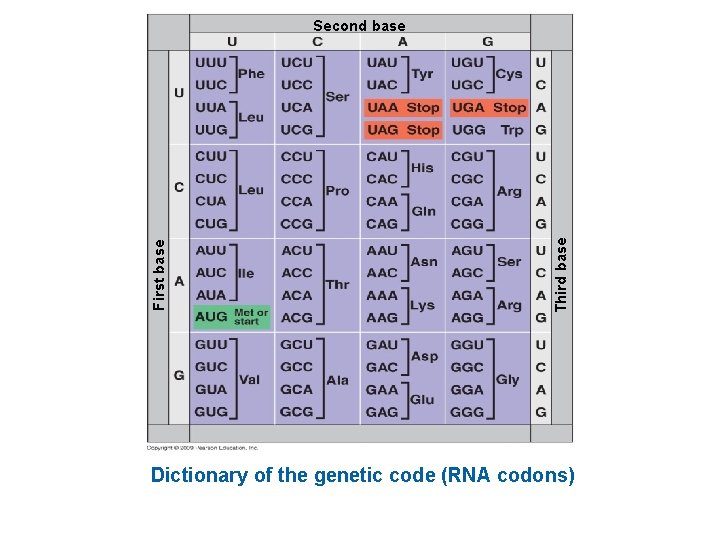
Third base First base Second base Dictionary of the genetic code (RNA codons)

Deciphering the genetic information in DNA Strand to be transcribed DNA Transcription RNA Stop codon Start codon Translation Polypeptide Met Lys Phe
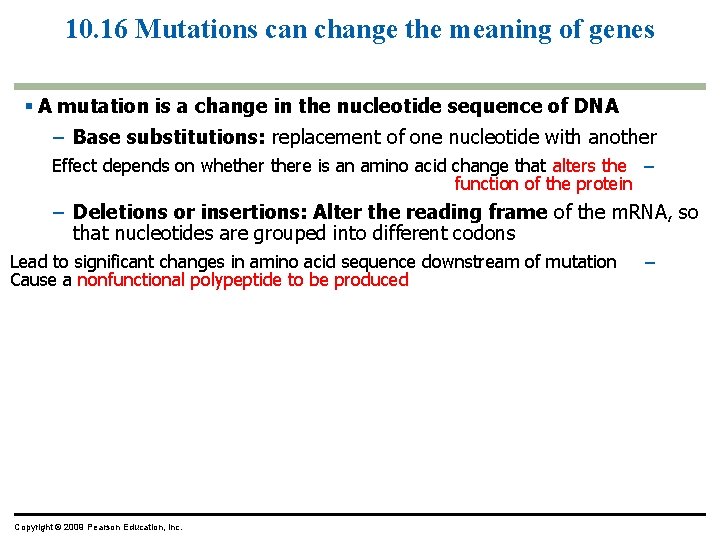
10. 16 Mutations can change the meaning of genes A mutation is a change in the nucleotide sequence of DNA – Base substitutions: replacement of one nucleotide with another Effect depends on whethere is an amino acid change that alters the – function of the protein – Deletions or insertions: Alter the reading frame of the m. RNA, so that nucleotides are grouped into different codons Lead to significant changes in amino acid sequence downstream of mutation Cause a nonfunctional polypeptide to be produced Copyright © 2009 Pearson Education, Inc. –

10. 16 Mutations can change the meaning of genes Mutations can be Spontaneous: due to errors in DNA replication or recombination Induced by mutagens High-energy radiation Chemicals Copyright © 2009 Pearson Education, Inc.
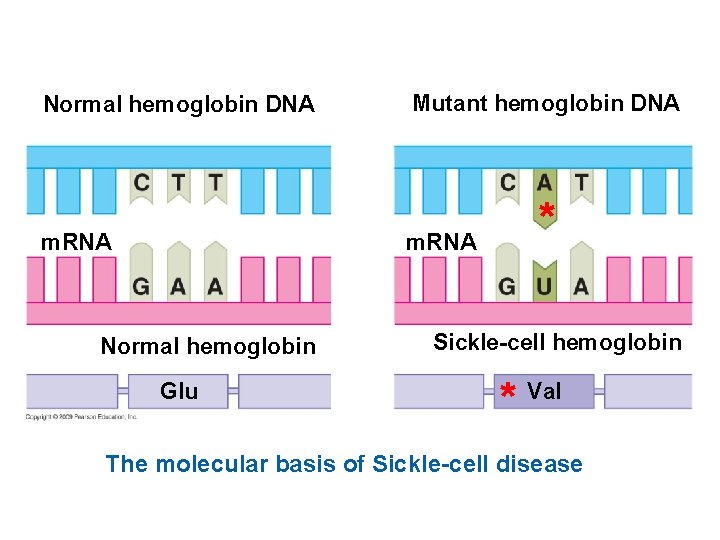
Normal hemoglobin DNA m. RNA Mutant hemoglobin DNA * m. RNA Normal hemoglobin Glu Sickle-cell hemoglobin * Val The molecular basis of Sickle-cell disease
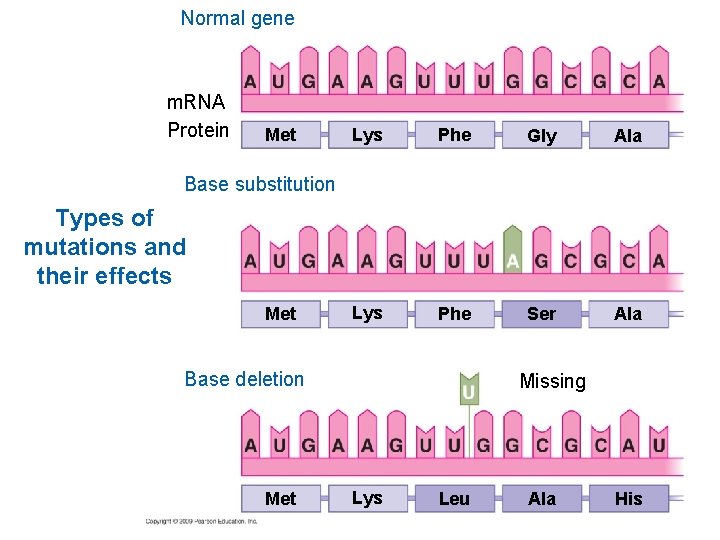
Normal gene m. RNA Protein Met Lys Phe Gly Ala Lys Phe Ser Ala Base substitution Types of mutations and their effects Met Base deletion Met Missing Lys Leu Ala His
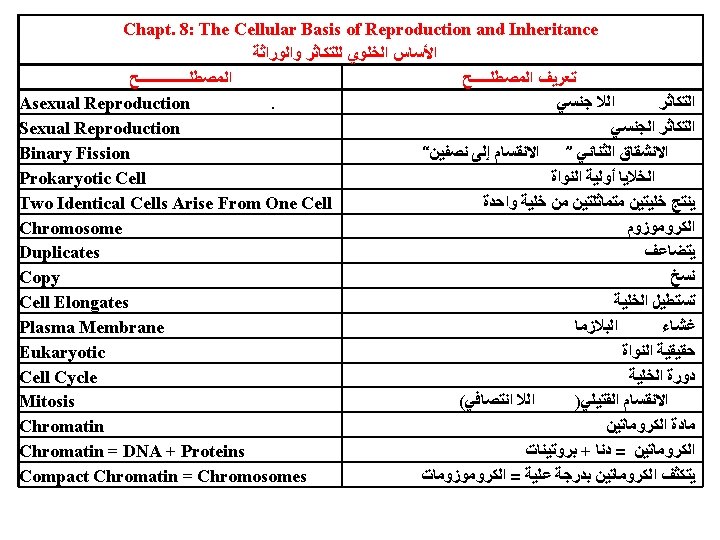

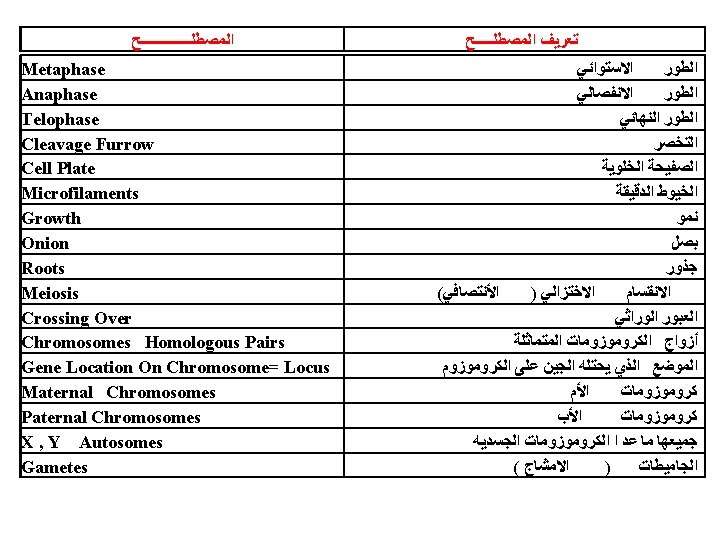
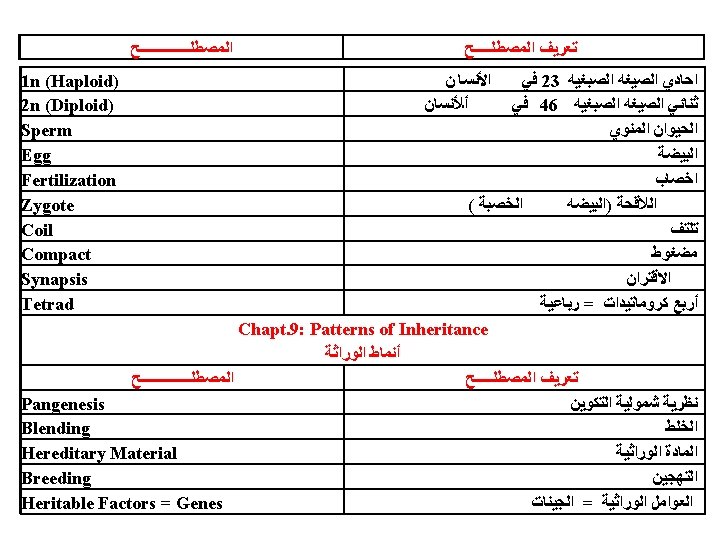




- Slides: 78